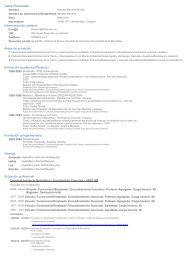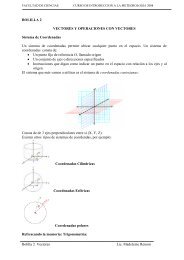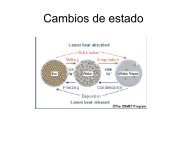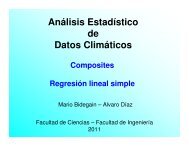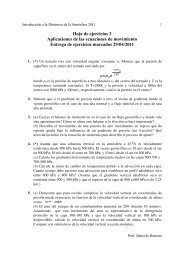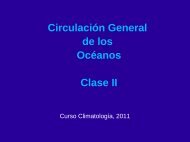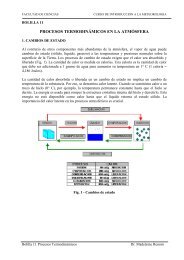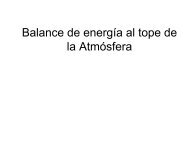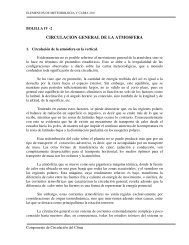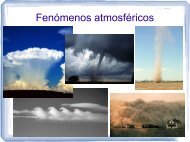Clasificación de Thornthwaite
Clasificación de Thornthwaite
Clasificación de Thornthwaite
Create successful ePaper yourself
Turn your PDF publications into a flip-book with our unique Google optimized e-Paper software.
Climatología Práctico<br />
2012
• Esta clasificación fue propuesta por Charles W. <strong>Thornthwaite</strong><br />
(climatólogo y geógrafo americano), en el año 1948.<br />
• El gran aporte que hizo <strong>Thornthwaite</strong> con esta clasificación<br />
fue usar la variable ETP como si fuera una variable<br />
atmosférica mas, tal como lo es la precipitación.<br />
• Los valores <strong>de</strong> precipitación y las salidas <strong>de</strong> agua (por ETP),<br />
nos permiten hacer un balance hídrico en el suelo y<br />
<strong>de</strong>terminar la presencia y monto <strong>de</strong> excesos, déficit y<br />
superávits <strong>de</strong> humedad.
• Esta clasificación esta estructurada con cuatro índices que en<br />
su conjunto expresan las características climáticas <strong>de</strong>l lugar;<br />
los dos primeros expresan el régimen <strong>de</strong> humedad <strong>de</strong>l lugar y<br />
los restantes el régimen térmico. Por ejemplo:<br />
B 4 r A´a´<br />
Indice Global <strong>de</strong> Humedad<br />
Variación estacional <strong>de</strong> humedad (VEH)<br />
Concentración estival <strong>de</strong> la<br />
eficiencia térmica<br />
Indice <strong>de</strong> eficiencia térmica (ETP)
• n: necesidad (<strong>de</strong> la vegetación) <strong>de</strong> agua anual, expresada<br />
como la ETP.<br />
• d: total anual <strong>de</strong> déficits mensuales <strong>de</strong> agua<br />
d= ETP-ETR<br />
• s: total anual <strong>de</strong> los exce<strong>de</strong>ntes mensuales<br />
s= RR-ETR<br />
• I h : Indice <strong>de</strong> humedad<br />
I h =100*s/n<br />
• Ia: Indice <strong>de</strong> ari<strong>de</strong>z<br />
Ia=100*d/n<br />
El Ia es máximo cuando la ETR es nula; entonces la <strong>de</strong>ficiencia <strong>de</strong> agua es igual a las<br />
necesida<strong>de</strong>s <strong>de</strong> agua. El Ia pue<strong>de</strong> alcanzar un valor máximo <strong>de</strong> 100%.
• Este índice es una combinación entre I h e I a , pero se le da mas peso al Ih<br />
<strong>de</strong>bido a la existencia <strong>de</strong> otras fuentes <strong>de</strong> humedad, como la humedad en el<br />
subsuelo, napas freáticas, etc, que pue<strong>de</strong>n apalear el efecto <strong>de</strong> una eventual<br />
sequía.<br />
• Por lo tanto, Thronthwaite plantea:<br />
Cada exce<strong>de</strong>nte <strong>de</strong> agua en cierta estación podría ser suficiente para inhibir<br />
la falta <strong>de</strong> agua en la estación siguiente hasta un total <strong>de</strong> 10 mm.<br />
• El índice Im se calcula como:<br />
I m =I h -0.6*I a<br />
• Este índice se clasifica en nueve tipos climáticos, que van <strong>de</strong>s<strong>de</strong> tipo árido<br />
hasta el perhúmedo, según la siguiente tabla:
Tipo climático Letra Im<br />
Perhúmedo A Im>100<br />
Húmedo B4 100>Im>80<br />
B3<br />
80>Im>60<br />
B2<br />
60>Im>40<br />
B1<br />
40>Im>20<br />
Sub-Húmedo a Húmedo C2 20>Im>0<br />
Seco a Sub-Húmedo C1 0>Im>-20<br />
Semiárido D -20>Im>-40<br />
Arido E -40>Im>-60
• Se clasifica en 10 tipos, 5 para climas húmedos y 5 para climas secos:<br />
Simbolo Ia/Ih Significado<br />
r Ia10 Solo climas secos (C1,D,E). Poco o ningun exce<strong>de</strong>nte en<br />
cualquier estación.<br />
S<br />
w<br />
16,7
Simbolo Ia/Ih Significado<br />
s 2<br />
w 2<br />
Ia>33,3<br />
Ih>20,0<br />
Ia>33,3<br />
Ih>20,0<br />
Fuerte variación estacional <strong>de</strong> humedad, siendo el verano la<br />
estación mas seca.<br />
En climas húmedos; gran déficit estival.<br />
En climas secos; gran déficit invernal.<br />
Fuerte variación estacional <strong>de</strong> humedad, siendo el invierno la<br />
estación mas seca.<br />
En climas húmedos; gran déficit invernal.<br />
En climas secos; gran déficit estival.
• Es el tercer simbolo <strong>de</strong> la clasificación. Se establece a partir <strong>de</strong><br />
los valores <strong>de</strong> ETP, clasificandose en 9 tipos:<br />
ETP (mm) Símbolo Tipo <strong>de</strong> clima<br />
n>1140 A` Megatermal<br />
1140>n>997 B4` Cuarto mesotermal<br />
997>n>885 B3` Tercer mesotermal<br />
885>n>712 B2` Segundo mesotermal<br />
712>n>570 B1` Primer microtermal<br />
570>n>427 C2` Segundo microtermal<br />
427>n>285 C1` Primer microtermal<br />
285>n>142 D` Clima <strong>de</strong> tundra<br />
142>n E` Clima <strong>de</strong> hielo
• Es el cuarto símbolo. Se halla tomando el cociente entre la<br />
ETP <strong>de</strong> los meses <strong>de</strong> verano sobre la <strong>de</strong> todo el año, en<br />
porcentaje:<br />
ETP (verano)/ETP (anual)*100<br />
Valores menores a 48,0<br />
Entre 48,0 y 51,9<br />
Entre 51,9 y 56,3<br />
Entre 56,3 y 61,6<br />
Entre 61,6 y 68,0<br />
Entre 68,0 y 76,3<br />
Entre 76,3 y 88,0<br />
Valores mayores a 88,0<br />
Símbolo<br />
a`<br />
b4`<br />
b3`<br />
b2`<br />
b1`<br />
c2`<br />
c1`<br />
d`



